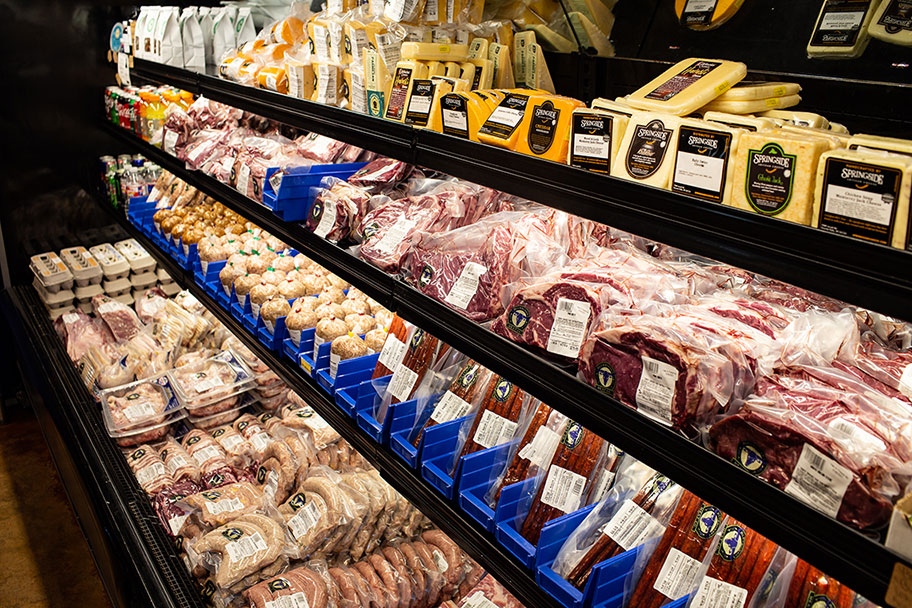What Makes Bagley Farms Meat Market Edwardsville IL Attract Attention for Meat Lovers
What Makes Bagley Farms Meat Market Edwardsville IL Attract Attention for Meat Lovers
Blog Article
Reveal the Art of the Butcher's Cut in a Modern Meat Market
In the ever-evolving landscape of modern meat markets, the butcher's cut has actually transcended its typical roots, combining age-old workmanship with modern methods. Today's butchers are not just cpus of meat; they are well-informed artisans that emphasize sustainability and moral sourcing. Their experience in choose and preparing cuts tailored to certain cooking requirements offers an unmatched eating experience. What really sets the modern butcher apart is their ability to forge a much deeper link between consumers and the origins of their meat. Exactly how do these masters equilibrium practice with innovation, and what effects does this have for the future of meat intake?
Evolution of Butchery Strategies
The advancement of butchery methods reflects a rich tapestry of technology and adaptation driven by developments in innovation, changes in consumer need, and a much deeper understanding of meat scientific research. Historically, butchery was a craft passed down via generations, with methods sharpened over centuries to optimize yield and taste. Nonetheless, the commercial change ushered in automation, transforming conventional techniques and allowing massive handling.
The mid-20th century saw butchery strategies even more improved by clinical insights right into muscle biology and meat aging, boosting both inflammation and preference. Developments like vacuum product packaging and refrigeration expanded item shelf-life, permitting butchers to diversify offerings and boost quality assurance. This period likewise noted the increase of specialized equipment, such as band saws and meat slicers, which boosted accuracy and performance in meat processing.

Computerized systems currently aid in monitoring pet provenance and optimizing cuts to fulfill particular customer choices. In addition, a revival in artisanal butchery has actually arised, mixing typical abilities with modern-day knowledge to cater to customers looking for honest and lasting meat alternatives.
Comprehending Meat Cuts
Understanding the complexities of meat cuts is vital for both butchers and customers seeking top quality and worth. Each cut originates from a different component of the pet, giving one-of-a-kind tastes, appearances, and food preparation methods - bagley farms meat market edwardsville il. Mastery of these distinctions not only improves culinary experiences yet additionally maximizes the utility of each carcass. For butchers, accurate cuts mirror skill and regard for the craft, making sure minimal waste and optimum yield.

Recognizing muscle mass composition is important; muscle mass used extra often by the pet often tend to be harder and are best matched for slow cooking methods, while less-used muscle mass, like those located in the loin, are more tender and perfect for grilling or roasting. Familiarity with these differences encourages consumers to make enlightened options, boosting their cooking undertakings.
Selecting High Quality Meat
Picking the best meat involves more than just choosing an aesthetically attractive piece from the screen. The art of selecting top quality meat needs a discerning eye and understanding of certain attributes that signify freshness and excellence.
Secondly, consider the marbling, which describes the white streaks of fat within the muscular tissue. Appropriate marbling is a crucial indicator of inflammation and flavor, as you can look here it thaws during food preparation, boosting the meat's juiciness. Keep in mind, greater marbling frequently correlates with superior high quality cuts, such as USDA Prime.
Texture is one more important aspect; meat should feel solid to the touch, not slimed or overly soft. In addition, bear in mind the scent. Fresh meat should have a clean, neutral odor, complimentary from any sour or off-putting odors.
Matching Cuts With Cooking Methods

On the other hand, tougher cuts like brisket and chuck roast are abundant in collagen, which breaks down into gelatin when prepared gradually. These cuts are suitable for braising or slow-moving roasting, enabling the meat to tenderize gradually his response and create deep, complicated flavors. Cuts such as brief ribs and pork shoulder fare well with slow-cooking methods, where expanded cooking times transform their robust structures right into succulent recipes.
Lamb shanks and oxtail, which call for long term food preparation to soften, are perfect prospects for stewing or slow simmering. These approaches coax out abundant, passionate flavors while preserving wetness. By comprehending the one-of-a-kind attributes of each cut, cooks and home chefs alike can elevate their cooking creations, making certain each meal is both satisfying and memorable.
The Butcher's Role Today
Navigating the advancing landscape of the contemporary meat market, the butcher's function today extends past plain prep work of cuts. Contemporary butchers are culinary artisans, instructors, and advocates for sustainable practices.
Along with crafting precise cuts, butchers currently engage straight with clients, using cooking guidance and customizing choices to fit specific requirements and preferences. Their expertise in meat aging, marbling, and taste profiles encourages customers to make educated decisions, enhancing their culinary experiences. This customized service exemplifies the butcher's advancing function as a trusted consultant in the cooking area.
Furthermore, butchers are crucial in minimizing waste, using whole pets to develop varied items such as sausages and supplies. This thorough approach not only respects the pet yet likewise straightens with modern sustainability objectives. By doing this, the contemporary butcher symbolizes both practice and innovation, adapting to an ever-changing market while preserving the creativity and honesty of their craft.
Verdict
The contemporary butcher's craft intricately weaves conventional methods with contemporary technologies, stressing lasting techniques and moral sourcing. Mastery in recognizing varied meat cuts and quality signs empowers butchers to provide enlightened my explanation recommendations, lining up certain cuts with ideal cooking techniques. This experience not just boosts culinary experiences however also strengthens the connection in between customers and the beginnings of their food. By honoring historical techniques while welcoming modern needs, the butcher's function remains vital in today's sophisticated meat market (bagley farms meat market edwardsville il).
Report this page